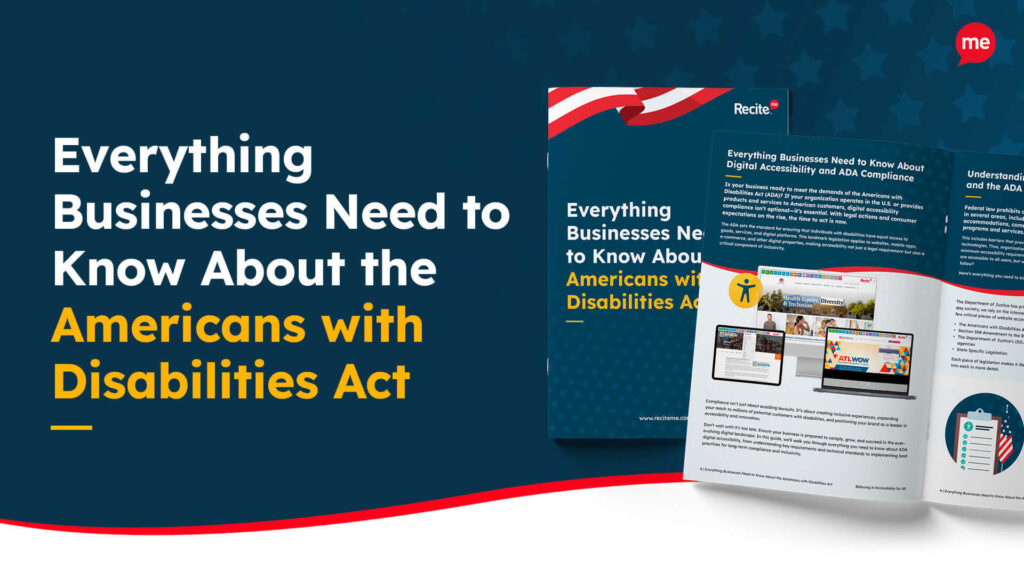Get A Free ADA Compliance Audit Of Your Website
Download NowToday, nearly all homebuyers search for a home online, and 52% of buyers have reported finding the home they ultimately purchased through online platforms. With such a significant portion of your prospective clients relying on your website, ensuring it’s accessible directly affects engagement, lead generation, and conversion.
Real estate websites, like any other place of public accommodation, must comply with the Americans with Disabilities Act (ADA). This article unpacks how ADA applies to real estate websites, what technical standards must be met, common pitfalls, and actionable steps you can take to achieve and maintain compliance.
How does the ADA apply to real estate websites?
The Americans with Disabilities Act was passed in 1990 to prohibit discrimination against individuals with disabilities in all areas of public life, including jobs, schools, transportation, and all places open to the general public. While it was originally written with physical spaces in mind, courts and the Department of Justice have consistently interpreted the law to extend to digital spaces, including websites.
Under Title III of the ADA, your real estate website is considered a “place of public accommodation.” That means it must be accessible to individuals with disabilities, just like your physical office. If your website offers property listings, contact forms, virtual tours, or other essential services, it’s crucial that all users can access that information. Otherwise, you could face legal action or damage your business reputation.


What technical standards must American real estate websites meet?
While the ADA doesn’t specify exact technical guidelines, the Web Content Accessibility Guidelines (WCAG) are the accepted industry standard for web accessibility.
WCAG 2.1 has three levels of conformance: Level A (The minimum level of accessibility), Level AA (The recommended standard that websites should strive for), and Level AAA (the highest standard).
For most real estate websites, you should aim to meet WCAG 2.1 Level AA to ensure your site is accessible to a broad range of users.
Want to make sure your website is compliant with the Americans with Disabilities Act? Then unlock the ADA compliance checklist now. Discover actionable steps to ensure ADA compliance, helping you avoid lawsuits and any other negative consequences of non-compliance.

What are the core ADA requirements for real estate sites?
To make your real estate website ADA compliant, you need to address several key areas where accessibility barriers frequently occur. Let’s break down each requirement, including what it is, how problems arise, and how you can fix them:

Alt text for images
Image alt text provides descriptions of images for users with visual impairments who rely on screen readers. When images lack alt text, these users miss out on important information about a property or feature. For example, an image of a living room might only have the alt text “image” or “living room,” which doesn’t convey any of the room’s features or its condition.
Add meaningful alternative text that describes the key features of each photo. Instead of generic labels, provide descriptions like “spacious living room with hardwood floors, large windows, and fireplace.” This enables screen reader users to visualize the space, understand the property’s features, and make informed decisions.
Keyboard navigation
Keyboard navigation ensures users can navigate your site using only a keyboard, without a mouse. Many real estate websites have interactive elements like menus, search filters, and sliders that are only accessible by mouse, making it impossible for keyboard users to use sophisticated filtering tools to filter listing searches.

To ensure your site is keyboard accessible, make sure all interactive elements, like buttons, links, forms, and filters,can be navigated using the keyboard alone. Each element should be focusable and display a visible focus indicator (like a border or highlight) so users can track their position on the page. Test your site without a mouse to confirm that users can move seamlessly through all key components, including property listings and search features.

Accessible multimedia
Visual content is popular with many people online, but videos without captions or transcripts exclude users who are deaf or hard of hearing.
Add synchronized captions to make all videos accessible, and provide written transcripts for audio content. For virtual tours or narrated videos, ensure that descriptions are available in text format as well.
Accessible forms and search filters
Forms and search filters allow users to search properties and make inquiries. However, many forms lack proper labels or use placeholder text instead of true labels, making them difficult or impossible for screen readers to interpret.
Make your forms accessible by labelling all form fields clearly, group them logically, and use appropriate ARIA-Labels if necessary. Provide accessible error messages that explain what went wrong and how to fix it.


Color contrast & readable fonts
Color contrast refers to the difference in brightness and color between foreground elements (like text) and background elements. Poor color contrast and small or cursive fonts can make text difficult to read, especially for users with visual impairments.
To make your site more readable, maintain a minimum contrast ratio of 4.5:1 for normal text. Use simple, clear fonts like Arial, Helvetica or Verdana, and avoid using color alone to convey important information.
You can check out our free color contrast checker tool here.
Logical page structure & heading hierarchy
Properly structured pages help users navigate content efficiently. Inconsistent heading levels or missing headings can make it difficult for screen reader users to understand the page’s layout.
To fix this issue, use headings in a logical sequence (H1, H2, H3) without skipping levels. This allows users to navigate sections more easily and understand the hierarchy of information.

Accessible documents & downloads
In real estate, downloadable documents like brochures, property disclosures, mortgage forms, and lease agreements are essential. However, if these files, especially PDFs, aren’t properly formatted, they can become major accessibility barriers. Users who rely on screen readers or other assistive technologies may be unable to read the content, navigate the file, or even know what the document is about.
To ensure your downloadable documents are accessible, tag PDFs properly, use structured headings, and avoid scanned images of text. Whenever possible, provide important content in both downloadable and HTML format directly on your website. HTML is typically more accessible, easier to maintain, and faster to load on various devices.
Download Your Free ADA Compliance Guide
Download NowCommon ADA violations specific to the real estate industry
Here are some common accessibility pitfalls in real estate websites, along with examples and solutions:
Unlabeled interactive map widgets
Interactive maps are a popular feature on real estate websites, helping users see property locations, explore neighborhoods, and view nearby amenities. But these maps often lack accessible labels and keyboard functionality.
For users relying on screen readers or keyboard navigation, this can make the information completely inaccessible. For example, if a user cannot tab to a map’s controls or receive descriptive labels about each pin, they miss essential details about property locations.
To address this, ensure all map controls (such as zoom buttons, pins, and toggles) have ARIA-Labels and are accessible via keyboard navigation. If the map itself cannot be made fully accessible, consider providing a text-based list of the same information, such as property addresses and their key features, so users have an alternative way to get the information.

Inaccessible virtual tours
Many real estate businesses utilize 3D and virtual tour solutions, such as Matterport, to showcase properties online. These immersive experiences help potential buyers explore the layout and flow of a property. But they also often lack keyboard support or alternative text, making them inaccessible to users with disabilities. For example, a blind user might not be able to navigate the virtual tour interface or receive meaningful information about the space’s layout and features.

If you include virtual tours on your website, ensure they are fully keyboard navigable. Users should be able to move between rooms or viewpoints using keyboard commands. Supplement the virtual tour with a descriptive text overview of the property’s layout, including details about each room and any unique features so users relying on screen readers can still understand the property’s highlights.
Carousel/Slider without focus control
Carousels and sliders are often used on real estate websites to highlight featured listings, showcase client testimonials, or promote upcoming events. Unfortunately, many of these components lack proper focus control, meaning users navigating with a keyboard or screen reader can’t interact with or pause the carousel. This can create confusion and hinder their ability to engage with important content.

To make sliders accessible, implement pause, play, and navigation controls that are keyboard accessible. Each slide should have a clear label indicating its content, and users should be able to navigate through the slides using standard keyboard keys, such as Tab and Arrow keys. Provide screen reader-friendly labels so that users know what each slide represents, e.g. “Slide 2 of 5: Featured Home on Maple Street.”
Insufficient error messaging in mortgage calculators
Mortgage calculators are essential tools on real estate websites, helping users estimate monthly payments and explore affordability. However, many calculators fail to provide accessible error messages, leaving users who rely on assistive technology without proper guidance if they make a mistake. For example, if a user enters an invalid value, they might receive no feedback at all, or the error might only be visible in a visual cue like a red outline.
To fix this, make sure your mortgage calculator shows clear error messages that screen readers can read out loud. Use tools like ARIA-live regions to make the error message appear automatically when something goes wrong. Be specific and helpful, for example, “Please enter a number for the loan amount” instead of just “Error.” Also, connect the error message to the exact field that needs fixing, so users know what went wrong and where to fix it.
Get a free automated ADA compliance audit of your website. This audit will highlight compliance violations and provide the recommendations needed to meet ADA compliance standards.

How to resolve ADA non-compliance on a realtor website
Need to get your real estate website ADA compliant? Don’t worry, there’s a wide variety of tools that can be leveraged to make the process stress-free. Let’s take a closer look:
1. Run an automated ADA compliance audit
First, perform an ADA compliance audit of your website to assess its current compliance level. To that end, you can use automated testing tools, such as Recite Me’s Web Accessibility Checker. This ADA website compliance testing tool, runs a quick, automated audit of your website, checking its level of conformance with WCAG 2.1 Level AA.
2. Conduct manual testing of your website
While automated tools are a great starting point, they can’t catch every accessibility issue. That’s where manual testing comes in. You can use tools such as a website accessibility checklist to manually assess your website for key compliance issues.
Start by manually testing high-traffic pages such as your homepage, property listings, contact forms, and search filters.


3. Implement the necessary fixes to become ADA compliant
Once you’ve identified accessibility gaps through your audit and manual testing, the next step is to take action. Work closely with your web developers, designers, and content team to make the necessary updates. This may include addressing missing alt text on images, fixing broken or unlabeled form elements, correcting heading structure, ensuring sufficient color contrast, and enabling full keyboard navigation.
Be sure to prioritize critical accessibility issues first, like inaccessible forms, and then work your way through less severe problems. This process may take time, but each fix brings your site closer to full compliance.
4. Schedule regular audits for the future
Web accessibility isn’t something you can set and forget. As your website evolves, it’s possible to inadvertently introduce new accessibility barriers. That’s why scheduling regular audits is essential.
Set a recurring schedule to review your website, as well as extra checks after redesigns or platform updates. Regular audits not only help you stay compliant but also demonstrate a long-term commitment to inclusive access, which is increasingly important to today’s socially conscious consumers.


5. Train staff on ADA best practices
A fully accessible website starts with an informed team. Whether it’s developers building new pages, marketers writing property descriptions, or customer support handling inquiries, everyone involved should understand the basics of web accessibility.
Provide regular ADA training to ensure your staff is aware of the importance of inclusive design and the specific accessibility best practices that apply to your site. Training should include topics like writing effective alt text, designing keyboard-friendly interfaces, using accessible color combinations, and understanding how screen readers work.
Does the Fair Housing Act impact ADA web compliance?
Yes! The Fair Housing Act (FHA) requires you to provide equal access to housing information, regardless of disability, race, or other protected characteristics. That means your website must be accessible so that people with disabilities can access the same housing opportunities as everyone else.
While the two legislations do not explicitly reference each other in their guidelines, this highlights how the ADA and FHA work together in harmony. As both Acts aim to ensure equal access to housing information both in physical and digital spaces.
Get Your Free ADA Compliance Training Course
Download NowWhat are the risks for realtors that do not comply with ADA standards?
Failing to meet ADA website accessibility standards doesn’t just exclude users with disabilities, it also exposes you to significant legal and financial risks. When your website presents digital barriers, you could receive an ADA compliance demand letter or even face a full-scale lawsuit.
ADA website accessibility lawsuits have surged in recent years. These legal actions can result in costly settlements, attorney’s fees, and court-mandated changes to your site. Plaintiffs often seek injunctive relief, which may require you to make immediate accessibility improvements under legal supervision.
Beyond the financial burden, non-compliance can damage your brand’s reputation, erode trust with prospective clients, and signal a lack of inclusivity. This is something today’s consumers are more attuned to than ever before. In short, overlooking accessibility not only puts you at odds with the law but can hurt your business in the long run.

Conclusion: Ensure your real estate website is ADA compliant now!
Making your real estate website ADA compliant isn’t just about avoiding lawsuits, it’s about ensuring that everyone can access your services and information. By following WCAG 2.1 Level AA guidelines and implementing the best practices outlined here, you’ll build trust, expand your audience, and create a more inclusive digital experience. Invest in accessibility now, and you’ll be investing in a stronger real estate business for the future.
Need more help becoming ADA compliant?
The following resources are packed full of actionable tips and expert advice for making your digital content compliant with the Americans with Disabilities Act:
Free ADA Accessibility Training
Take the first step to ADA compliance by completing our training course.
Free ADA Accessibility Guide
Ensure your organization is meeting the requirements for ADA compliance.










